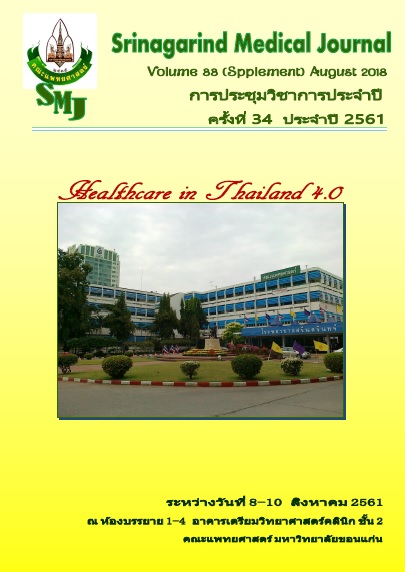The Development of Random Platelet Concentrates (PC) in Platelet Additive Solution (PAS). Blood Transfusion Centre. Faculty of Medicine Khon Kaen University, Thailand
Keywords:
Random platelet concentrates (PC), Platelet additive solutions (PAS)Abstract
Background and Objective: Platelet additive solutions (PAS) are crystalloid nutrient media used in place of plasma for platelet storage. They replace 60-70% of plasma in platelet components. So the amount of storage plasma can be decreased. Platelet stored in PAS have been demonstrated to have a lower risk for allergic transfusion reactions and appeared to have equivalent clinical efficacy for controlling bleeding, compared to platelets stored in 100% plasma and increase storage time to 7 days with bacterial detection test and due to decrease in the titer of ABO agglutinins, platelets in PAS do not require ABO compatibility between donor plasma and recipient cells or use as universal platelet. The separation of random platelet concentrates (PC) from whole blood is base on the differential densities of various cellular components when blood is subjected to variable centrifugation forces. The problem in our routine work is 3.8% of PC showed no swirling features before 5 days. This study aimed to prepare PC in PAS in our routine work, instead of the traditional PC.
Methods: Whole blood (WB) was high-speed centrifuged before separation by automated system. PC was prepared by an alternative approach involved PC preparation from a single buffy coat (BC) unit by adding approximately 50-70 ml of plasma/PAS before centrifugation, followed by transfer of the PC to a 300 ml transfer bag and stored in a flat agitator at 20-24°C for up to 5 days after collection and observed the swirling every days. The PC were measured volumes, residual leukocyte and platelet content. The pH was determined on day 6 at 20-24 °C.
Results: Random PC in traditional method ( n=31) had the mean of volume 51.3 ml and platelet yields 9.4X1010 cells/unit. Compared to the PC in PAS (n=43) had the mean of volume 62 ml and platelet yields 7.2X1010 cells/unit. 100% of PC in PAS increased storage time to 7 days and the mean of pH 6.72 while the traditional PC had storage time only 4 days and the mean of pH 5.69.
Conclusions: PC in PAS increased storage time to 7 days 100% and provides reached the recommended quality of Council of Europe (EU), American Association of Blood Banks(AABB) and National Blood Centre, Thai Red Cross Society (TRC);random PC had content more than 5.5X1010 cells/unit, volume 50-70 ml, pH>6.4.
References
Rock G, Swenson SD, Adams GA Platelet storage in a plasma-free medium. Transfusion 1985; 25: 551-6.
Holme S, Heaton WA, Courtright M. Improved in vivo and in vitro viability of platelet concentrates stored for seven days in a platelet additive solution. Br J Haematol 1987; 66: 233-8.
Van der Meer PF, Pietersz RN, Tiekstra MJ, Huijgens PC, Dekker WJ, Reesink HW. WBC-reduced platelet concentrates from pooled buffy coats in additive solution: an evaluation of in vitro and in vivo measures. Transfusion 2001; 41: 917-22.
Vamvakas EC, Blajchman MA. Transfusion-related mortality: the ongoing risks of allogeneic blood transfusion and the available strategies for their prevention. Blood 2009; 113: 3406-17.
Heddle NM, Klama L, Singer J, et al. The role of the plasma from platelet concentrates in transfusion reactions. N Engl J Med 1994; 331: 625-8.
AABB Association Bulletin #10-06-Information Concerning Platelet Additive Solutions, October 4, 2010.
Kerkhoffs JL, van Putten WL, Novotny VM. Dutch-Belgian HOVON cooperative group. Clinical effectiveness of leucoreduced, pooled donor platelet concentrates, stored in plasma or additive solution with and without pathogen reduction. Br J Haem 2010; 150: 209-17.


